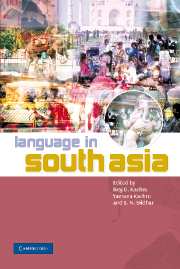Book contents
- Frontmatter
- Contents
- List of Figures
- List of Maps
- List of Tables
- Preface
- Acknowledgments
- List of Abbreviations
- Note on Transcription
- Introduction: languages, contexts, and constructs
- Part 1 Language history, families, and typology
- Part 2 Languages and their functions
- Part 3 Sanskrit and traditions of language study
- Part 4 Multilingualism, contact, and convergence
- Part 5 Orality, literacy, and writing systems
- 13 Orality and literacy
- 14 Writing systems of major and minor languages
- Part 6 Language conflicts
- Part 7 Language and modernization
- Part 8 Language and discourse
- Part 9 Language and identity
- Part 10 Languages in diaspora
- References
- Subject Index
- Language Index
- Author Index
14 - Writing systems of major and minor languages
Published online by Cambridge University Press: 04 May 2010
- Frontmatter
- Contents
- List of Figures
- List of Maps
- List of Tables
- Preface
- Acknowledgments
- List of Abbreviations
- Note on Transcription
- Introduction: languages, contexts, and constructs
- Part 1 Language history, families, and typology
- Part 2 Languages and their functions
- Part 3 Sanskrit and traditions of language study
- Part 4 Multilingualism, contact, and convergence
- Part 5 Orality, literacy, and writing systems
- 13 Orality and literacy
- 14 Writing systems of major and minor languages
- Part 6 Language conflicts
- Part 7 Language and modernization
- Part 8 Language and discourse
- Part 9 Language and identity
- Part 10 Languages in diaspora
- References
- Subject Index
- Language Index
- Author Index
Summary
Introduction
South Asia has been home to a nearly unique variety of writing systems over the past four millennia and more, comprising: one of a handful, worldwide, of script inventions out of nothing; two highly sophisticated adaptations of phonetic writing, grounded in preexisting linguistic theory; a plethora of paleographic, epigraphic, and typographic descendants; two successive adoptions of world scripts from the West; and a number of inventions of local scripts for local languages.
Indus script
Little can be said about the writing system that appears to have originated on South Asian soil, the so-called “Indus Valley” script, or Harappan (for the site where it was first found, in 1872–1873), because it has not yet been deciphered. One difficulty is that the inscriptions, virtually all of which are on small seals, are very short; another is that the language they record is not surely identified (though a form of Dravidian is the most likely candidate). Even the number of discrete characters is uncertain, since we cannot be sure which variants represent distinct signs, which might represent modifications of base forms, and which might simply represent scribal/artistic freedom.
The inscribed Indus seals date from about 2500 bce on and have been found throughout the Indus Valley region; a few have even turned up in Persian Gulf lands and Mesopotamia. They went out of use around 2000 bce, when their cities seem to have been abandoned due to climate change (rather than to invading Aryans, who appear on the scene perhaps half a millennium later).
- Type
- Chapter
- Information
- Language in South Asia , pp. 285 - 308Publisher: Cambridge University PressPrint publication year: 2008
- 5
- Cited by



